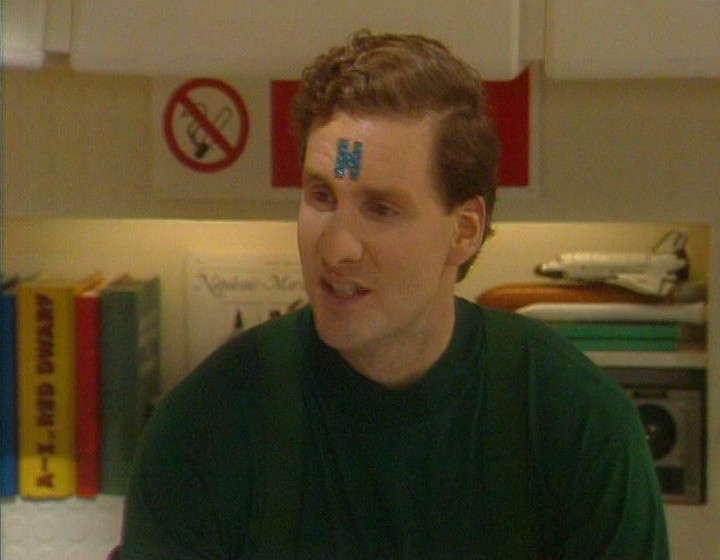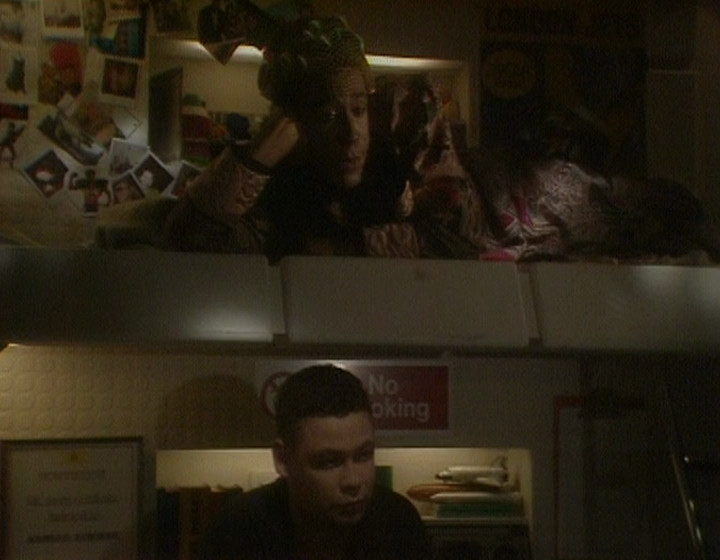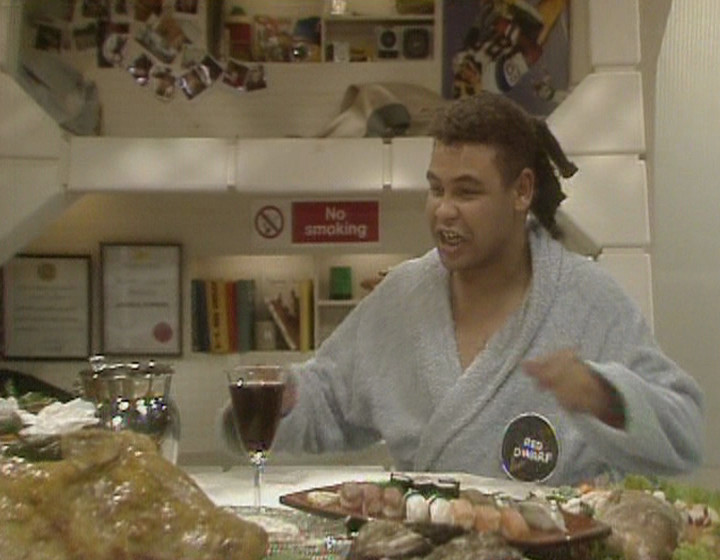Reshoots. The problem is always damn reshoots.
Let me explain. Over the last few years, I’ve been doing various bits of research into some of the nitty gritty about Red Dwarf‘s production. (Stuff like this article on the BBC Manchester studios is the result of that.) And once you get into the really complex stuff, knowing exactly when a scene was shot starts to become important.
But no problem, right? By this point, the production dates of Red Dwarf – at least for most of the studio material – are widely known. When telling the story of Series III, for instance, we can easily thread our way through the production order of the episodes, rather than the transmission order.
The issue: reshoots. Just because the majority of an episode was shot on a particular date, it doesn’t mean all of it was. Because productions have this nasty tendency to reshoot things they think they can do a better job of, weeks down the line. Damn them.
A case in point. Here is a scene from “Timeslides” (TX: 12/12/89), featuring the famous Tension Sheet:
But this was not the original version of the scene. This, at least, has been known for nearly two decades now. Back in 2003, Series III was released on DVD, with plenty of deleted scenes included in the extras. And one of these scenes was the following: the original version of the above bunkroom scene, reshot because they didn’t like the “hologram box” effect.
It’s always slightly surprised me that the bothered to reshoot this scene, really. I never thought the effect was bad enough to make it worth changing. Regardless, they reshot the scene at a later date, and took the chance to rescript it a little too.
So the question we have is: when did they reshoot this scene? We have no idea. We know that the original version of “Timeslides” was shot on the 11th and 12th of September 1989. But concerning the date of the reshoot, we don’t have a clue.
That sounds like a job I might be interested in. Let’s see if we can figure it out.
Firstly, we need a list of the recording dates for each episode:
| Episode | TX Date | RX Dates |
|---|---|---|
| Backwards | 14/11/89 | 18-19/9/89 |
| Marooned | 21/11/89 | 4-5/9/89 |
| Polymorph | 28/11/89 | 3-4/10/89 |
| Bodyswap | 5/12/89 | 25-26/9/89 |
| Timeslides | 12/12/89 | 11-12/9/89 |
| The Last Day | 19/12/89 | 10-11/10/89 |
So this means the series was shot in the following order: Marooned, Timeslides, Backwards, Bodyswap, Polymorph, and The Last Day. Which means that unhelpfully, the scene could have been reshot during any of the last four episodes.
At this point, as ever, the desire for a complete set of camera scripts for Red Dwarf makes itself keenly felt. Sadly, I have access to precisely none of them for Series III. So the only other possibility is to look at what clues we can find on-screen. Perhaps the sets. Specifically: how the sets are dressed.
Now at this point, Red Dwarf was still being shot in Manchester, in a vaguely traditional fashion. Rehearsals at Acton, two days in the studio, and then the set was struck until the next week. Which means that when the set was rigged again for the next episode, certain things might be arranged slightly differently.
Certain things like, I don’t know… the order of the books on the shelf in Rimmer’s bunk, perhaps.
Let’s take a look. Firstly, the order of those books in the opening scene of “Timeslides”.1

Blue. Yellow. Red. Green.
Now let’s take a look at them in the original, unbroadcast version of the Tension Sheet scene:

Blue. Yellow. Red. Green.2
And now let’s look at them in the reshot version of the Tension Sheet scene, as seen in the broadcast episode:

Blue. Red. Yellow. Green.
The middle two books are switched around. Proof that the scene really was reshot during production of a different episode. But when, exactly?
The following week, “Backwards” was recorded…

It’s a little difficult to make out, but a bit of squinting does the job: Blue. Yellow. Red. Green. Nope.
OK, how about “Bodyswap”?

Blue. Yellow. Red. Green. Again.
“Polymorph”?

Hello there. Blue. Yellow. Green. With what looks like the red book off to the right. But we’re still not matching the reshot scene.
Which means we’re down to the final episode shot in the series, “The Last Day”.

Blue. Red. Yellow. Green. And we have a winner. The reshot version of the Tension Sheet scene in “Timeslides” was recorded during “The Last Day”, on the 10th or 11th of October 1989. Just sneaking in the reshoot before production on the series ended.3
Which leaves us just to ponder one other thing. For the reshoot of this scene, they did rather more than simply remove the hologram box effect. Rob and Doug rewrote the scene, keeping the same key points, but changing around a few things, along with adding and removing some gags. I certainly think the world is a better place for the addition of the “ate his wife” punchline in the final version.
But the reshoot does more than that. In the original version of the scene, Rimmer is his usual, slightly bad-tempered self. In the reshoot, he’s annoyingly chipper, contrasting far better with Lister’s depressed mood. On reflection, it really does work better than the original version, and not just because of the removal of the hologram box. Perhaps it really was worth doing after all.
Anyway, if anybody wants to write a fanfic about Rimmer rearranging his books during the middle of “Timeslides” to explain the continuity error, then feel free. Just make sure I’m credited.
On second thoughts, just make sure I’m not credited.
In some of these pictures, there’s a green book on the far left of the shelf, which is only visible on the close-ups. I’m ignoring that one, as it’s irrelevant to our main point, and just confuses things. ↩
In this shot, it is clear that the yellow book is the A-Z of Red Dwarf. This is the same prop that Lister finds Rimmer’s diary hidden in during “Me²”, back in Series 1. ↩
There is perhaps the question of whether Series III had a pickup week at the end of the production, like Series 1 and 2 had. I’ve found absolutely no evidence of such an extra week anywhere, either in the documentation, or on-screen anomalies. I’m willing to bet it never had one, and Series III only had six weeks of studio recordings… unless you know differently. ↩
